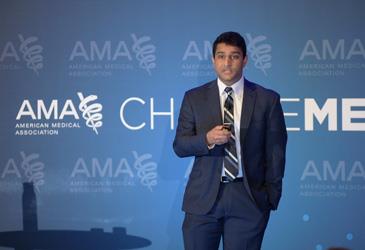 Students are exploring creative ways to share project ideas and collaborate with faculty to transform physician training. Here’s how one student leveraged his peer network to help pilot a new curriculum and spur future student innovation.
Students are exploring creative ways to share project ideas and collaborate with faculty to transform physician training. Here’s how one student leveraged his peer network to help pilot a new curriculum and spur future student innovation.
A big data project sparks bigger ideas
Last year, New York University School of Medicine launched a novel toolset, Health Care by the Numbers, a dynamic curriculum that allows students to analyze real clinical data for more than 2.5 million patients from 29 hospitals in New York and answer population health questions.
NYU created the open source data project as part of its groundbreaking work within the AMA’s Accelerating Change in Medical Education Consortium, which consists of 11 leading medical schools that became founding members after receiving $1 million AMA grants in 2013 to launch innovative medical education projects. The AMA is in the process of awarding a second set of grants and adding up to 20 schools to the consortium.
When Abhi Amarnani, an MD-PhD student at SUNY Downstate Medical Center, learned of Health Care by the Numbers, he imagined how he and his classmates would benefit from such an expansive project, so he shared the idea with this peers. Using the AMA’s Medical Student Section network in New York, Amarnani located students who helped him engage and connect with NYU faculty.
This initial connection gave rise to a student-led collaboration that allowed SUNY Downstate students to pilot NYU’s Health Care by the Numbers at their school. The program offers students a flexible three-year, individualized, technology-enabled curriculum to improve care coordination and quality.
The foundation is virtual patient panels derived from de-identified patient data gathered from NYU Langone Medical Center physician network practices and open data sources. Students can immerse themselves in these panels and explore a robust collection of real patient data that simulates a practice group setting. Students learn how to use this big data for patient and population management. The course also offers ePortfolios for students to track their own activities for quality improvement, safety and value-added care.
“Even though I’m at SUNY Downstate—a school that is not in the [Accelerating Change in Medical Education] Consortium—I’ve worked very closely with [faculty at NYU] to bring the program to our school at SUNY Downstate,” Amarnani told educators at the AMA’s CHANGEMEDED 2015 conference. “I was able to do that because of the strength of our Medical Student Section in New York.”
Amarnani was among a pilot group of students at SUNY Downstate who worked with faculty mentors to explore Health Care by the Numbers. After piloting the program, Amarnani said faculty are now working to launch the digital data toolset as part of its official curriculum.
Amarnani said disseminating information about the NYU project via his network of peers allowed students and faculty at SUNY Downstate to pilot a new program without having to ask multiple committees or councils at his school to approve it. Instead, he and his peers freely explored NYU’s Health Care by the Numbers as part of their own research. This represents a new way—outside the traditional path of faculty academic networks—for them to test and share the program with their classmates, Amarnani said.
Note: SUNY Downstate would like to clarify that the Health Care by the Numbers project is not yet an official part of the curriculum and that all curricula are reviewed and approved by its curriculum oversight body.




